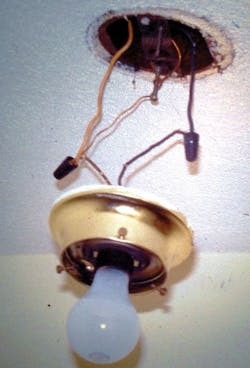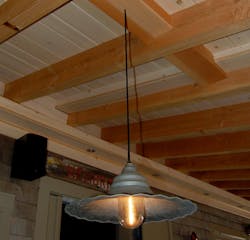Hint: Neutralized
Tell Them What They Have Won...
Using the 2011 NEC, correctly identify the Code violation(s) in this month’s photo — in 200 words or less — and you could win a $50 gift check. E-mail your response, including your name and mailing address, to [email protected], and Russ will select three winners (excluding manufacturers and prior winners) at random from the correct submissions. Note that submissions without an address will not be eligible to win.
NOVEMBER WINNERS
Our three winners this month were: Kent Mertilien, an electrical engineer for RS&H in Merritt Island, Fla.; Garret S. Kerly with URS Corp. in Tampa, Fla.; and Sheldon Sadofsky, an inspector for the City of Omaha, Neb. Each was able to correctly identify the following violations with this suspended light fixture.
Section 400.8(2) of the 2011 NEC prohibits flexible cords and cables from being run through holes in walls, ceilings, or floors. Section 400.8(5) also prohibits these cords or cables from being concealed by walls floors or ceilings. I could not determine if there was an outlet box installed for this light fixture. However, if there is an outlet box buried behind the wood on the ceiling, then there is a violation of 314.29, which requires boxes to be installed in a manner that the wiring inside the box is accessible “without removing any part of the building or structure.” That is not possible in this case. If there is not a box installed behind the wood, then there is a violation of 300.15, which generally requires boxes to be installed at each outlet point, splice point, or junction point when the wiring method is tubing, conduit, or cables.





